Thanks for your support! If you make a purchase using our links in this article, we may make a commission. And, as an Amazon Associate, I earn from qualifying purchases. See the full disclosure here.
Updated April 13, 2024
Your travel trailer ball hitch is an essential part of your towing setup. Without it, your trailer isn’t going anywhere. But things can get a little confusing. Why are there four different sizes for travel trailer ball hitches?
How do you know which one is right for you? How do you know you’re using travel trailer ball hitches correctly? We’ll let you know.
Thankfully, it’s not as complicated as it seems. Let’s take a look at the different sizes of ball hitch for travel trailers. Plus, we’ll look at some tips for using your travel trailer ball hitch and of course some of the best brands to buy.
- How Do I Know What Size Hitch Ball I Need?
- The 4 Most Common Travel Trailer Ball Hitch Sizes?
- 6 Tips For Using Your Travel Trailer Ball Hitch
- 1. Watch Your Weight
- 2. Use Lubricant
- 3. Use a Hitch Pin Lock
- 4. Use a Weight Distribution Hitch
- 5. Keep Everything Level
- Can A Trailer Hitch Ball Break Off While Driving?
- How to Calculate the Rise or Drop for Your Ball Mount
- 6. Always Match Your Hitch Ball and Coupler Sizes
- What are the Advantages of Using Adjustable Travel Trailer Ball Hitches?
- The Best 5 Brands of Travel Trailer Ball Hitches
- 1. Equal-i-zer
- 2. CURT
- 3. Weigh-Safe
- 4. Reese Towpower
- 5. Draw-Tite
- Are Trailer Chains Required By Law?
- Final Words About Travel Trailer Ball Hitch Size
- Related Reading:
- Mike Scarpignato – Bio
How Do I Know What Size Hitch Ball I Need?
One of the first places to look for the right size hitch ball is on the side of the coupler at the front of the RV. If it’s worn off or rusted and you can’t read the hitch ball size requirement, your next destination is the RV’s manufacturer’s manual.
The most common Hitch ball size for a travel trailer is 2”, though 2 and 5/16” and 1 and ⅞” are also fairly common.
The 4 Most Common Travel Trailer Ball Hitch Sizes?
The most common travel trailer ball hitch sizes are:
- 1-7/8 inch hitch balls are for lightweight towing under 3,500 lbs. Some smaller trailers, particularly older pop-up campers, might use this ball. But otherwise, this size can’t handle enough weight for most RV towing.
- 2-inch hitch balls are for medium-weight towing, with weight ratings up to 12,000 lbs. available.
- 2-5/16 inch hitch balls are for heavyweight towing and can have ratings up to 20,000 lbs. (or slightly more). Because they handle more weight, these are the travel trailer hitch ball sizes you’ll see for most towable RVs.
- 3-inch hitch balls are only used for gooseneck towing. This type of towing hitch isn’t typically used for hauling fifth-wheel RVs.
For most RVers, the standard travel trailer hitch ball size will be 2” or 2-5/16”. Smaller travel trailers will usually use a 2” ball, while heavier trailers will need the 2-5/16” ball.
Besides the diameter of the hitch ball, there are some other measurements you’ll see. Two measurements are the length and diameter of the “shank” – the threaded stem below the ball. There’s also the rise, which is the height the ball sits off its base.
6 Tips For Using Your Travel Trailer Ball Hitch
When you use your travel trailer ball and hitch, there are a few things you should keep in mind for the best experience. Following these tips will keep you safe and help keep your trailer in good condition.
1. Watch Your Weight
It’s incredibly important to never exceed your towing system’s weight capacity. Going over by even a couple pounds can be incredibly unsafe.
The weight limit of your trailer ball is also known as the ball capacity. This number is usually found on the top of the hitch ball or at the base of the shank.
Keep in mind that your hitch ball isn’t the only part of your towing system. Your hitch and your RV trailer hitch ball mount also have their own weight limits.
The weight limit for your hitch will be on a label somewhere on the hitch. The ball mount’s limit will usually be on a label on the front or along the shaft that slides into the receiver.
Your max weight limit is only as high as the lowest limit for all three. So if your hitch is rated for 10,000 lbs, your ball is rated for 8,000 lbs, and your mount is rated for 6,000 lbs, your towing limit is 6,000 lbs.
2. Use Lubricant
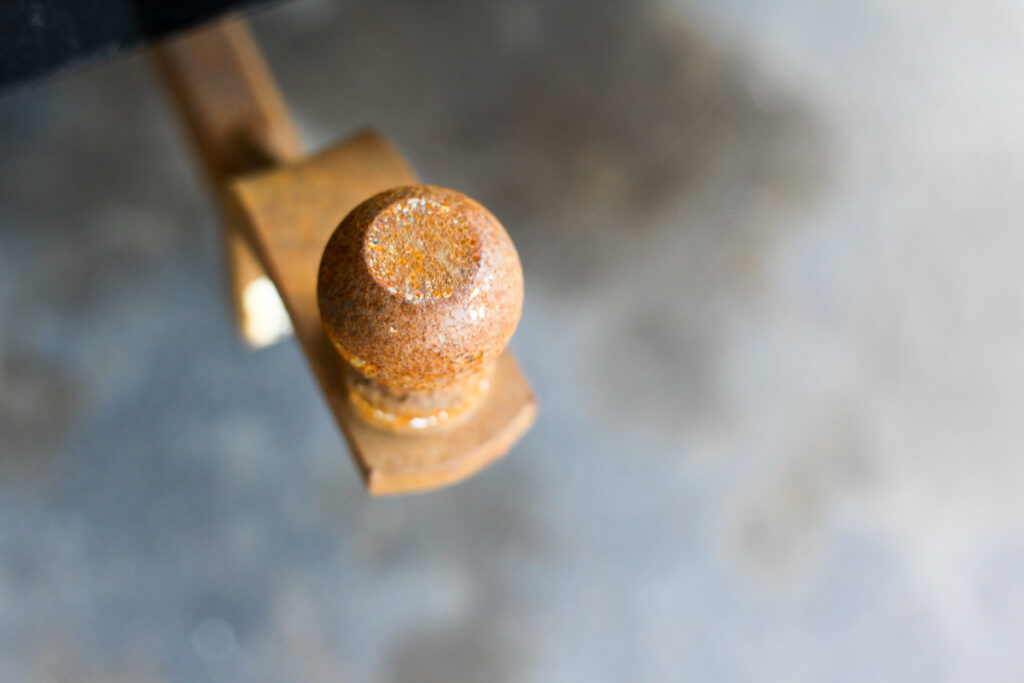
You can use your travel trailer ball hitch without lubricating it first, but lubrication is highly recommended. Lubrication ensures structural integrity and prevents noise, but it also keeps your ball from getting rusty.
You should grease your hitch ball at least twice a year. If you’re keen to keep it performing at its best, it’s recommended that you apply some lubricant before leaving on a trip. When you put on a new coat, make sure you wipe off the old one first.
3. Use a Hitch Pin Lock
You’d think that nobody would try and steal something as big as a travel trailer, but sadly, you’d be wrong.
A travel trailer is no small investment, not to mention that if it gets stolen mid-trip, you’re out of a place to sleep. So to keep someone from driving off with your home on wheels, it’s smart to use a hitch pin lock to keep your trailer safe.
A hitch pin lock will keep anyone from disconnecting your trailer from the trailer hitch or from connecting it to their vehicle when you’re not using it. There are two different kinds: receiver-style and coupler-style.
A receiver hitch lock is a metal pin with a lock on one or both ends. It protects your trailer when it’s hitched up to your vehicle. However, it won’t help you when the trailer isn’t attached.
Coupler hitch locks protect your trailer even when it’s not attached to your tow vehicle. They’re like a big U-lock for your hitch. Without the proper key, connecting a trailer is impossible.
4. Use a Weight Distribution Hitch
A weight distribution hitch is often recommended when towing a travel trailer. These hitches help distribute the trailer’s weight evenly.
With improperly distributed weight, most of the force is borne on your tow vehicle’s rear axle. This has a hugely negative impact on steering, traction, and your ability to stop. Or, you can also have the opposite problem. If you have too little tongue weight, your trailer will become more prone to sway.
A weight distribution hitch uses a pair of spring bars that go from your flat-tow vehicle to the trailer. These springs apply leverage to spread the load out evenly onto your vehicle’s front axle and your trailer’s rear axle. This will give you a stable, level, and smooth ride also preventing your vehicle from sagging.
Not all weight distribution hitches have sway control, but if your hitch does, it will also avoid a lot of sway.
There are some minor downsides to weight distribution hitches, including harder turns and more time spent hitching and unhitching. However, it’s a good idea to use one for larger loads and heavier trailers. If you’re unsure if you need one, check your tow vehicle’s manual for guidance.
5. Keep Everything Level
It’s absolutely essential that your travel trailer and tow vehicle be level with the ground.
However, most vehicles and trailers won’t line up perfectly. The difference in height is referred to as the “rise” or the “drop” – depending on whether the camper trailer ball hitch is higher or lower than the coupler.
Can A Trailer Hitch Ball Break Off While Driving?
Anything is possible, though it takes some torque or a previously compromised hitch ball to happen. Most of the time, when trailers come uncoupled from the towing vehicle, it’s because of a failure in the connection somewhere along the line, rather than the hitch ball snapping clean off.
The kind of sudden torque that will snap a hitch ball is only supposed to happen in the event of the RV flipping, so it doesn’t flip the towing vehicle with it. For the same reason, you’re not supposed to use the hitch ball for recovery. In other words, don’t attach something to the hitch ball to pull a car out of a ditch, or something similar.
A hitch ball is designed for security, not for the pulling and pushing forces of a recovery, or the sudden twisting of a coupled trailer.
How to Calculate the Rise or Drop for Your Ball Mount
To calculate the rise or drop of your ball mount, measure the distance between your trailer’s coupler and the ground to get your coupler height. Then, measure the distance between your hitch receiver to the ground to get your hitch height.
Subtract your coupler height from your hitch height and you’ll have your rise or drop. A positive number means a drop and a negative number means a rise.
For example, if you have a 17” hitch height and a 13” coupler height, you need a 4” drop. For the same coupler on a 12” hitch, you would need a 1” rise.
You’ll need an RV trailer hitch ball mount that fits this number. Many ball mounts can be installed in either direction to give a drop or a rise. Adjustable travel trailer ball hitch mounts can also be set at whatever height you need.
6. Always Match Your Hitch Ball and Coupler Sizes
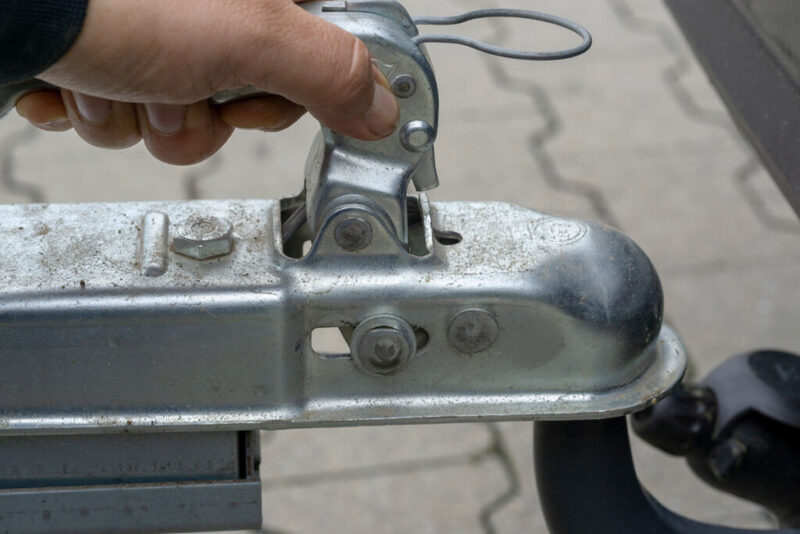
Your RV trailer hitch ball size doesn’t mean a thing if it doesn’t match your trailer’s coupler. The coupler is the part of the trailer that connects to the hitch ball. It slides over the ball and is clamped shut to provide a sturdy hold that can still move with you on the road.
The differences between travel trailer hitch ball sizes don’t seem too major. Couldn’t you just use a 2-5/16” coupler on a 2” ball?
The answer is absolutely not! Even that small difference can lead to your trailer detaching from your vehicle. That can result in a damaged trailer and can also put other people in danger.
Always ensure your coupler and camper trailer ball hitch are the same sizes. Doing otherwise is a recipe for disaster.
What are the Advantages of Using Adjustable Travel Trailer Ball Hitches?
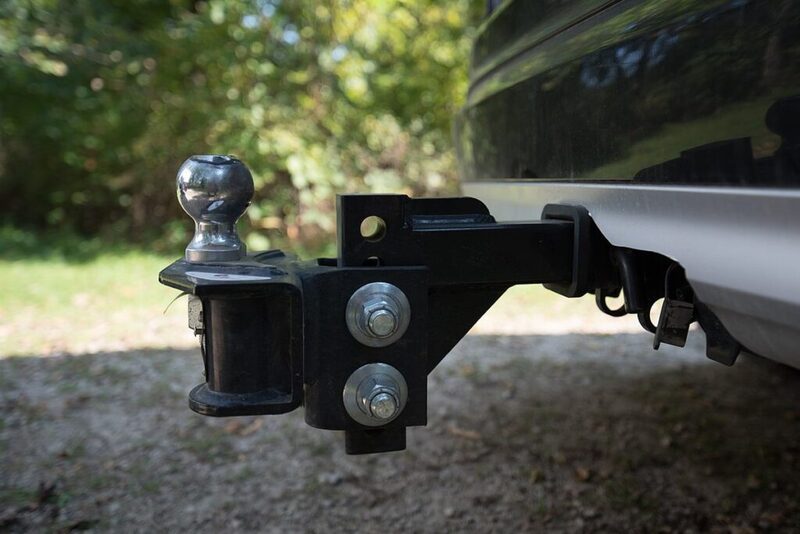
Your hitch ball and your RV trailer ball mount can both be adjustable in different ways.
Adjustable drop ball mounts let you change the height of the ball mount to meet the rise or drop required for your trailer to be level. This precision and control let you get everything perfectly level.
There are also different kinds of ball hitches for travel trailers that can be adjusted in various ways.
A switch trailer ball is basically a trailer ball shank with a removable head. You switch out the different sizes of balls as you need them.
There are also double – or even triple-sided hitch balls. These have different sizes of hitch balls on a single mount. Simply rotate to the ball you need for any given circumstance.
If you only expect to tow the same trailer all the time, these different hitch balls might not be of much use to you. But if you tow other things besides your travel trailer, they can really come in handy.
The Best 5 Brands of Travel Trailer Ball Hitches
Now that you know all about ball hitches, let’s look at some options for the best ball hitch for a travel trailer.
1. Equal-i-zer
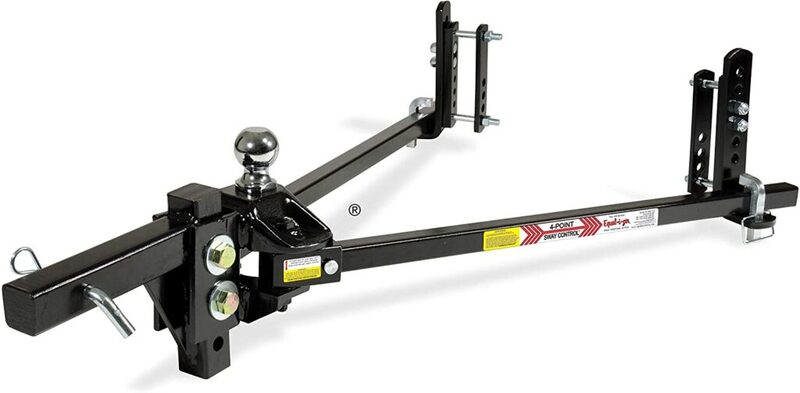
Equal-i-zer weight distribution hitch is one of the most popular brands of trailer hitches with 75 years of history. They were also the brand that created the first sway control hitch.
These hitches provide even weight distribution and their special “4-point sway control” to eliminate trailer sway. Plus, Equal-i-zers are 100% American-made using high-quality American steel and include a lifetime warranty.
The heavy-duty model is rated up to 16,000 pounds and has a great weight distribution system. The company recommends a 2 5/16 ball for the best pairing.
2. CURT
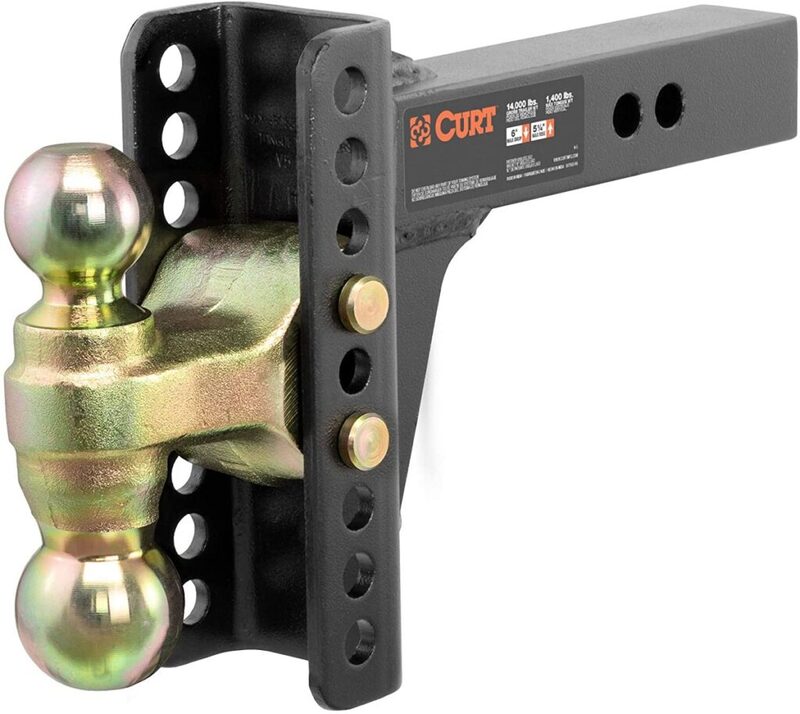
CURT Manufacturing Adjustable Travel Trailer Ball Hitch Mount is an industry leader in manufacturing USA-made trailer hitches. They offer a huge array of hitches for any need and are all rigorously safety tested to give you peace of mind.
CURT has any kind of hitch you could need including weight distribution hitches. If you need any accessories, like hitch locks or wheel chocks (if this is your first RV, you definitely need these), they’ve got you covered there too.
This particular model comes with a 2-inch and 2 5/16-inch ball hitch. It’s rated at 14,000 pounds and can provide a 6-inch drop.
3. Weigh-Safe
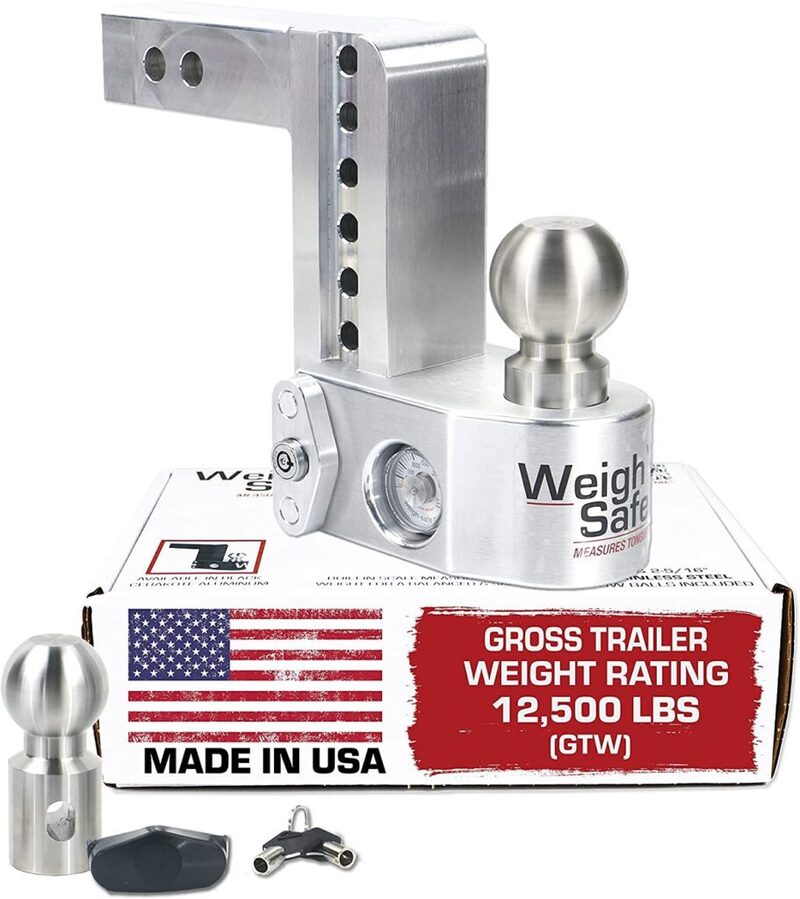
Worried about your weight? A Weigh-Safe adjustable travel trailer ball hitch mount can give you some peace of mind.
Weigh-Safe’s claim to fame is that their hitches are the only ones on the planet with a built-in scale. This measures the tongue weight of your tow load, helping you balance your load and improve performance. Plus, Weigh-Safe makes all their products from high-quality materials to the highest specifications.
4. Reese Towpower
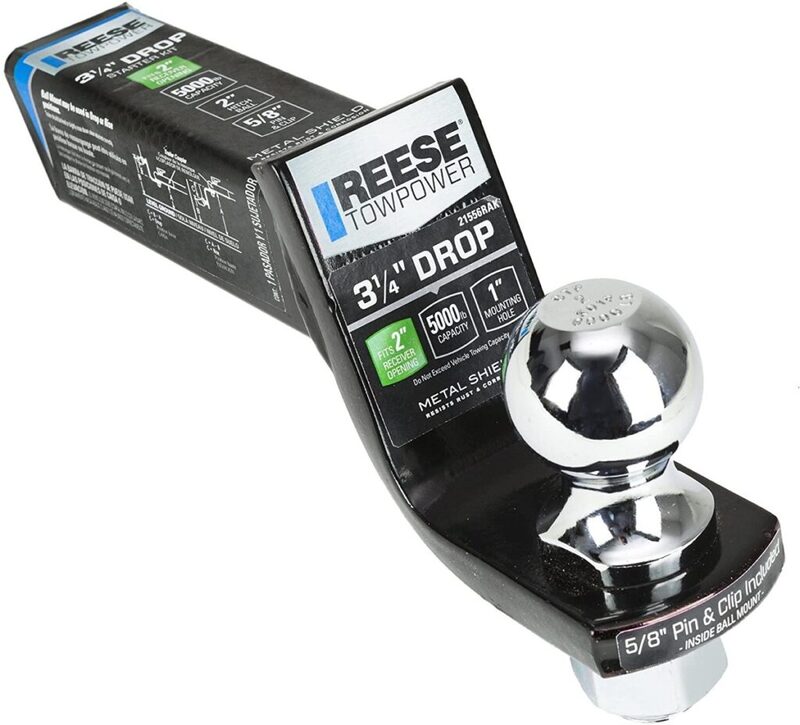
Reese Towpower is a big name in towing that has been around since 1952.
RVers might know Reese Towpower best for their heavy-duty fifth-wheel hitches, which are a popular choice for you guessed it – fifth-wheel trailers. But they also carry just about any towing product you need, and it’s all covered by a 1-year warranty!
Take a look at their starter kit with a 3-¼” drop mount and a 2” hitch ball rated for up to 5,000 lbs.
5. Draw-Tite
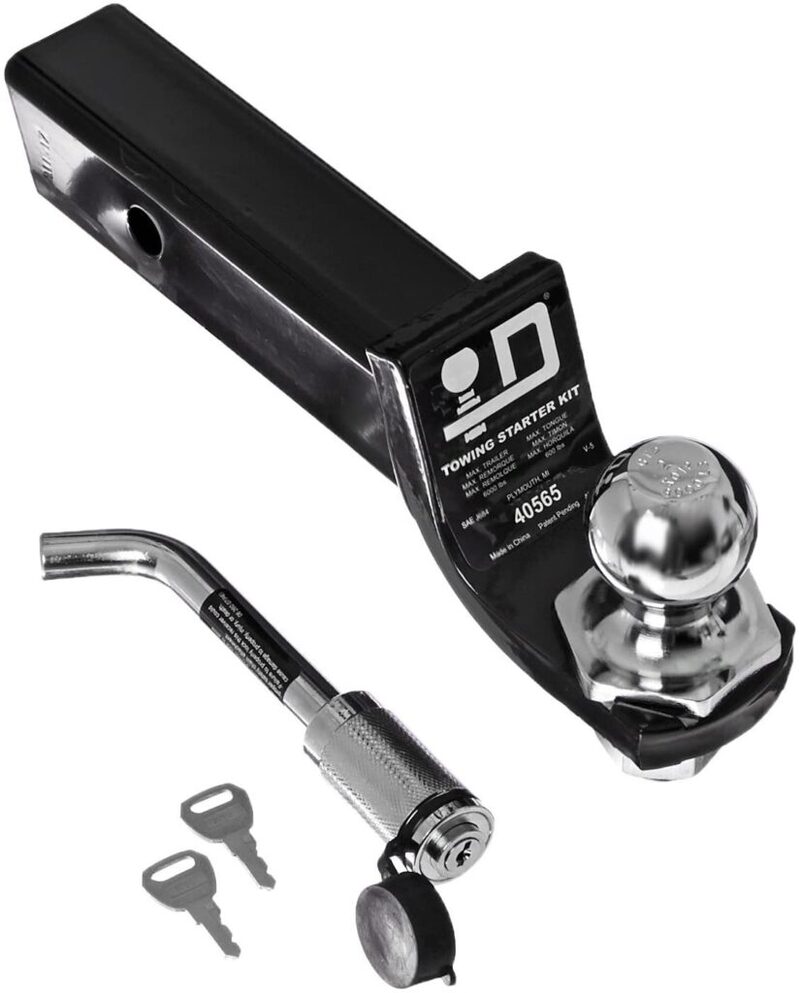
Draw-Tite produces top-quality, rigorously tested trailer hitches and they’ve been doing it since 1946. This makes them one of the most trusted brands for travel trailer ball hitches. Every Draw-Tite hitch is also backed by a lifetime warranty.
Consider their starter kit with a 2” drop mount and a 2” hitch ball included, as well as a receiver lock.
Are Trailer Chains Required By Law?
Most states require safety chains on a traditional hitch and tow operation. The same is not true of fifth-wheels, though they are fundamentally different on every level and don’t need chains as a backup safety measure.
The purpose of the chains on a hitch and ball setup is self-evident. In a case where the coupler comes loose from the ball, the chains act as a safety catch. They aren’t designed to continue towing the trailer, but only to keep an unmitigated disaster from occurring in the case of decoupling.
Final Words About Travel Trailer Ball Hitch Size
Your travel trailer ball hitch is one of the most important parts of your whole towing system. One little ball is where your trailer attaches to your vehicle, so it’s important to have the right one.
For the majority of RVers towing a travel trailer, the suitable trailer hitch ball size is going to be 2″ or 2-5/16”. No matter what size you’re towing, it’s critical to ensure your setup is correct and calibrated for your rig. What your buddy is doing may not be exactly right for you.
Now you know everything you need to know about travel trailer ball hitch sizes, it’s time to hitch up and hit the road!
Related Reading:
– Should I Grease My Trailer Hitch Ball or Not?
– 35 Biggest RV Beginner Mistakes to Avoid!
– RV Hookups Explained (Water, Sewer, Electric)
– How To Stop Travel Trailer Sway
Mike Scarpignato – Bio
Mike Scarpignato created RVBlogger.com over five years ago in 2018 to share all we have learned about RV camping.
Mike is an avid outdoorsman with decades of experience tent camping and traveling in his 2008 Gulf Stream Conquest Class C RV and 2021 Thor Challenger Class A motorhome.
We attend RV Shows and visit RV dealerships all across the country to tour and review drivable motorhomes and towable trailers to provide the best evaluations of these RVs in our blog articles and YouTube videos.
We are 3/4-time RVers who created RVBlogger.com to provide helpful information about all kinds of RVs and related products, gear, camping memberships, tips, hacks and advice.


